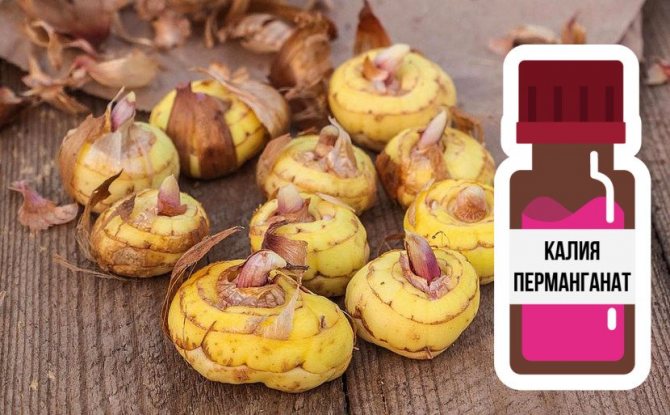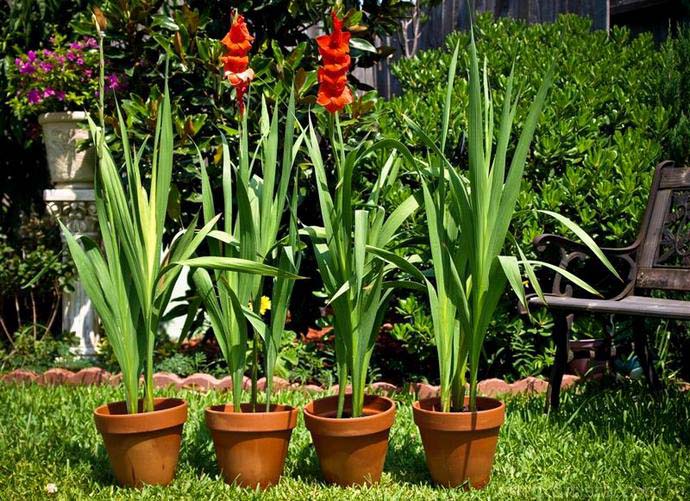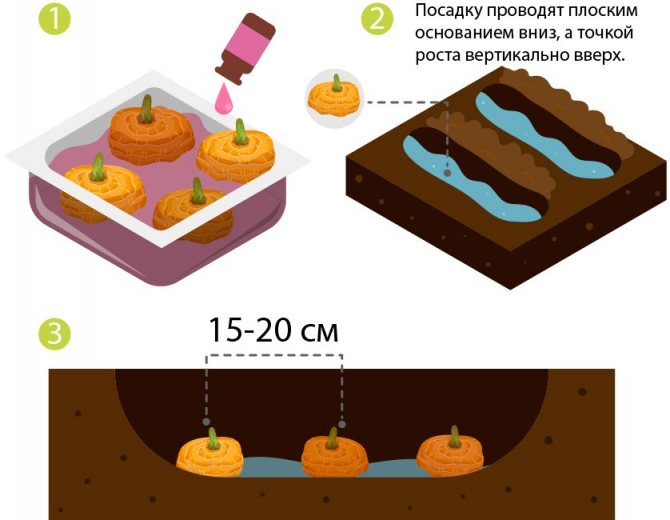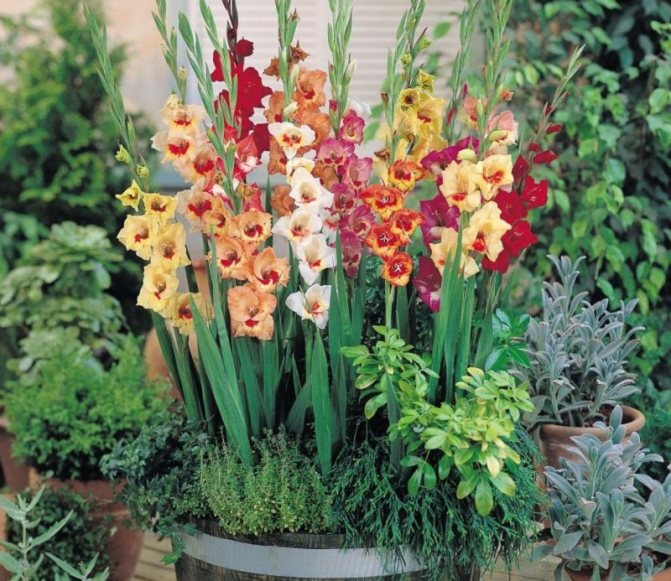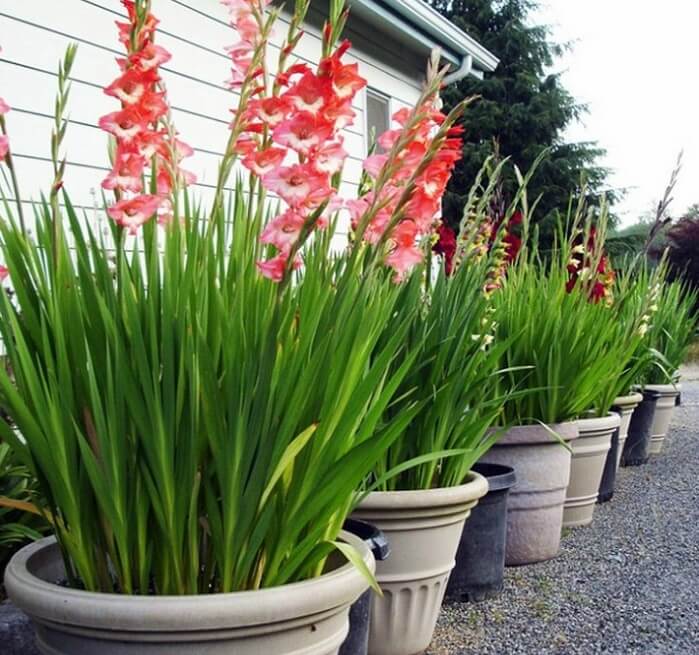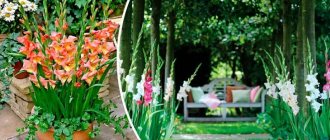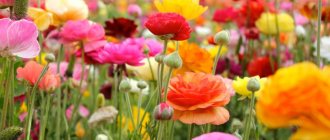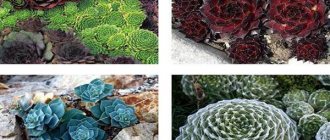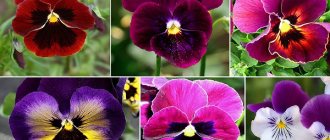Do you want to plant gladioli in pots? Then, you should familiarize yourself with the correct selection of planting containers, the subtleties of planting, the peculiarities of caring for gladioli, as well as the rules for maintaining optimal climatic conditions. Following the advice of professionals, you will definitely be able to preserve the health and beauty of gladioli.
Most gardeners are at least roughly familiar with gladioli. These flowers can be a great decoration for a flower bed or outdoor flower garden. It is believed that gladioli are exclusively outdoor flowers, since adult plants are large in size - tall stems and a powerful root system that goes deep into the ground. In this regard, gladioli require a lot of space for normal existence. However, today, breeders have also developed miniature varieties of gladioli that can be bred even in an apartment. As part of this article, we want to tell you about how to plant gladioli in a pot.
Features of such a landing
The first thing to consider before the "pot" planting of gladioli - not all varietal varieties can be grown in this way. Given the ability of the culture to quickly grow root mass, many of its representatives can only be grown in an open area. For indoor floriculture, only those that usually do not grow taller than 60-80 cm (mainly varieties with small or medium-sized flowers) are suitable options.
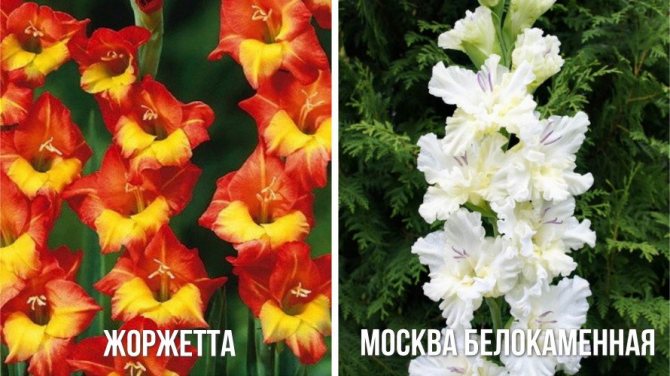
The most suitable for container cultivation are the following varieties of gladioli:
- White City. A flower from a primrose group, 3.5–7.5 cm in diameter. A flowering spike-shaped inflorescence can consist of 23 small snow-white flowers.
- Columbine. Another primrose variety, with small flowers. The reddish-white flowers distinguish the variety favorably from the rest, making the plant a highly decorative element for any flower bed.
- Tinkerbell. This variety is classified as a butterfly type. Basically, the flower grows up to 45-75 cm in height and looks great in a flowerpot. The inflorescences are of the spike-like type and are formed by bright orange flowers with a yellow throat. As in the previous case, this color makes them an excellent addition to any flower garden.
- Melodie... The inflorescences of this variety have a pinkish tint, with an accent in the form of a scarlet bright spot in the center. Mature plants can be 80 cm tall, so they can only be planted in oversized pots.
- Georgette. Red-yellow representatives of the variety will look great in any flower arrangement, in particular when decorating the territory with potted flower crops.
- Moscow White stone. Unusual gladioli, up to 60 cm high. In one spike-shaped inflorescence, there are up to 40 flowers with corrugated petals.
Did you know? Gladioli were known to people as early as 300 BC. e., however, in those days no one purposefully cultivated them, on the contrary, plants were considered weeds, and the ancient Greeks tried in every way to get rid of them.
Gladioli. Short description
The Iris family has many plants of incomparable beauty. A popular member of this family is gladioli, or skewers.The perennial corm has been known for a long time and has a rich history. The natural habitat is the tropics and subtropics of Europe, Asia and Africa. Skaters are distinguished by a variety of shapes. There are tens of thousands of varieties of garden gladioli and at least two hundred natural species.
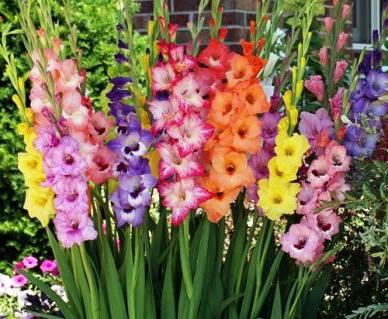

The graceful long plant has vertical stems. Its height ranges from fifty centimeters to one and a half meters. Rigid leaves, which reach eighty centimeters in length, rush upward like a sharp blade of a sword. Funnel-shaped flowers have different colors and shapes. The spike-shaped inflorescence can be quite dense or loose.
Disembarkation instructions
Placing gladioli in pot containers begins with choosing the optimal version of such a container, preparing the substrate and plant material for further cultivation. In order to achieve the most positive result from all the work performed, it is worth paying attention to each of the listed stages.
Video: Planting gladioli in pots
What is needed for landing
In addition to the pot and soil, other requirements of these colors should be taken into account before planting. For example, the place of their growth should be well illuminated by the sun's rays, which means that when growing indoors, you need to prepare such a place in advance: on the windowsill or balcony, if there is a suitable temperature.
Did you know? In the Middle Ages, gladiolus was considered one of the indispensable plants in folk medicine and was specially grown to prepare a medicine for toothache and improve lactation in women after the birth of a child.
A decrease in temperature values to + 13 ° C can extend flowering, so immediately make sure that you can regularly ventilate the space at the location of the plant. In the southern part of the house and without air conditioning, gladioli may not withstand the high summer temperatures and will quickly die.
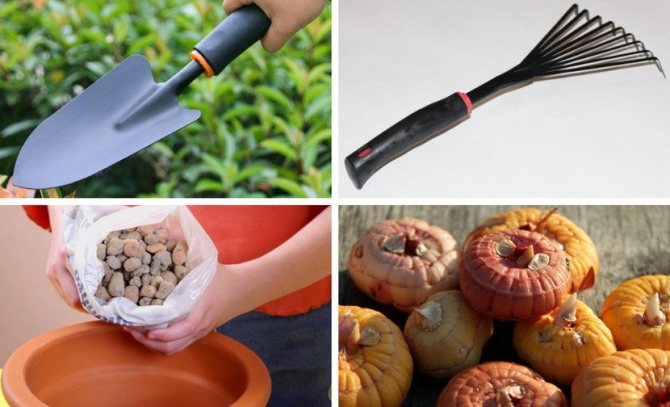

Of the tools and materials for planting, you may need a shovel, a mini-rake for fluffing the soil, expanded clay or broken brick to organize a drainage layer, and, of course, the planting material itself (mainly in the form of bulbs). As for the specific time of planting, it is better if it is mid-spring.
Also learn how to plant gladioli in a flower bed correctly and beautifully.
Preparing the soil and pot
When choosing a planting container, it is imperative to take into account its main characteristics of the product: material of manufacture and dimensions. For most "pot" varieties of gladiolus, suitable parameters for such containers will be a diameter of 20-30 cm and a depth of about 30-45 cm. What exactly you choose, clay pots or long plastic containers - it doesn't matter, the main thing is that they all have drainage holes for removal of excess moisture from the rhizome of flowers.


As for the substrate, the ideal option for flowers would be a light and structured soil, sufficiently nutritious and moisture-absorbing. You can buy such a substrate ready-made, but in order to save a little, it is worth mixing black soil with chalk or crushed eggshell (50 g is enough for 2-3 kg of soil), a mixture of phosphorus and potassium (about 10 g for 2 kg of soil). Loams can be mixed with sand and peat before filling into containers.
Important! If you take soil from a garden or vegetable garden for a flower culture, after mixing with the rest of the components, it should be calcined in the oven, which will get rid of all pathogenic microbes and pest larvae. The earth is calcined within 30 minutes at an oven temperature of + 70 ... + 90 ° C.
Flower preparation
The preparation of the material for planting begins with its selection.Successful flower cultivation is possible only when using whole and absolutely healthy bulbs of the selected variety (miniature or small-flowered). For disinfection of the material, a half-hour etching in a solution of potassium permanganate (0.1%) or 12-hour soaking in a previously diluted preparation "Cytovit" is suitable.


In the latter case, such preparation should be performed no later than 2-3 weeks before the immediate planting of the bulbs, after which they are stored in dry boxes for the rest of the time. If individual specimens have not sprouted before the day of disembarkation, it is better to discard them and never plant them.
You may be interested to know if gladioli can become pollinated and change color.
Planting a plant
Planting flower bulbs can be called quite a common process, because all that is required from the grower is simply to deepen the planting material (with a small sprout upwards) into the loosened substrate by 10-12 cm, leaving at least 5-6 cm of free space between the “neighbors”.
The first aerial shoots usually germinate after 14–21 days, and then the pots are moved to a calm and well-lit place (do not allow moisture to affect the aerial part of the plant).
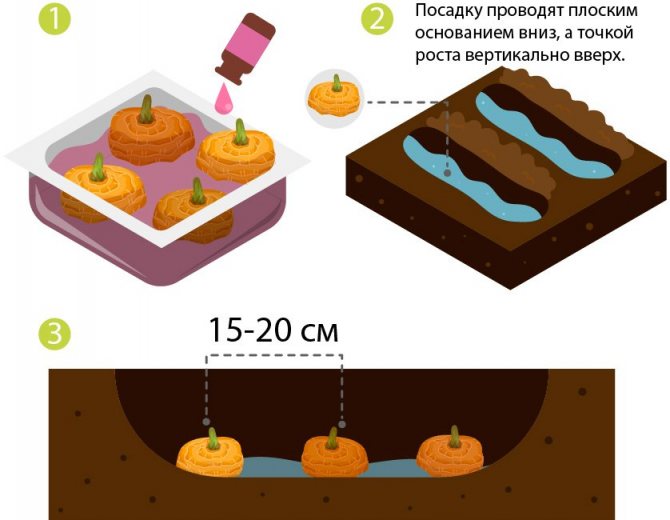

Irrigation and feeding technology
Indoor gladioli produce rather large and tall inflorescences, but an insufficiently powerful root system is not able to provide an ornamental culture with moisture from the deep soil layers. Irrigation activities should be supportive, therefore, overdrying of the earthen coma, as well as its excessive waterlogging, should not be allowed. To get a colorful and abundant flowering, the culture must be provided with regular watering with settled water at room temperature. The soil in the flower pot must be moistened to its full depth. Water during irrigation should not fall on the foliage and gladiolus flowers.
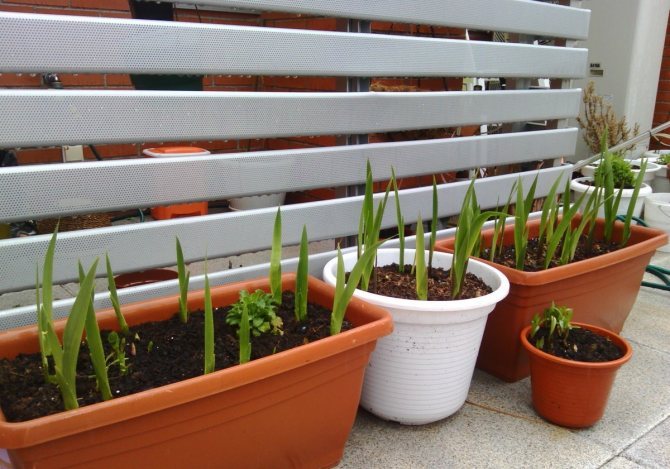

A limited amount of nutrient medium in a flower pot requires careful attention to feeding, therefore it is recommended to apply fertilizers according to the following scheme:
- after the formation of the first true leaf, the ornamental culture must be fed with nitrogen-containing fertilizers with the addition of potash compounds;
- at the stage of formation of the fourth leaf, 10 g of nitrogen fertilizers and 10 g of potassium fertilizers are added to the soil of the flower pot with the addition of a gram of boric acid;
- after the appearance of the sixth leaf, 10 g of nitrogen fertilizers and 15 g of potash fertilizers are applied;
- in the phase of the appearance of peduncles and at the beginning of flowering, a full-fledged mineral fertilizer is used for feeding;
- after flowering, the decorative culture must be fed with potassium-phosphorus fertilizers without fail.
A good result is obtained by using special fertilizers for flowering ornamental crops for feeding indoor gladioli.


Proper plant care
Soon after planting, a long process of flower care begins. As with growing any other flower crops at home, it is important to take into account several main aspects: watering and fertilizing plants, loosening and mulching the soil, garter and pruning gladioli. They all have their own characteristics that you should know about before planting plants.
About
A flower garden at home. Agrotechnical cultivation
Before growing gladiolus on a window or balcony, you should study the conditions of planting and the content of these flowers. In the open field, gladioli are planted at a soil temperature of at least ten degrees Celsius. In conditions of closed ground, skewers begin to be planted from mid-April.
When choosing a place for placing pots and containers on a windowsill, balcony or loggia, it should be borne in mind that gladioli are heat-loving and light-loving plants.Containers with flowers are placed in well-lit places. Plants do not tolerate drafts and low air temperatures. When growing on a balcony, you need to monitor the temperature. When the temperature drops to ten degrees Celsius, the containers are temporarily brought into the room.
The first shoots appear two or three weeks after planting. During this time, it is important to ensure that the flowers are properly hydrated. Lack of moisture will definitely affect the growth of the plant. It will be weak and lose its decorative shape. Provides moderate watering, avoiding waterlogging. Moisture retention can be ensured by mulching with peat. At the same time, it will serve as an additional plant nutrition. You should also pay attention to air exchange. The soil in the container is constantly loosened, thereby providing air access to the gladiolus root system.
The next important point is feeding gladioli. In indoor conditions, you cannot do without them. How to grow flowers to ensure an adequate diet?
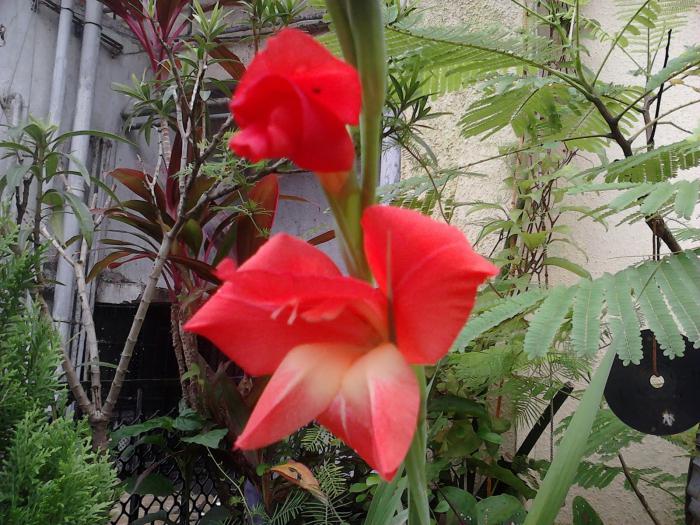

The normal development and flowering of gladioli will require three to four foliar dressings with mineral fertilizers, for the preparation of which the following substances are dissolved in one liter of water:
- ammonium nitrate - 0.5 g;
- superphosphate - 0.5 g;
- potassium chloride - 0.5 g
The timing of fertilizing is as follows:
- the first is the appearance of three leaves;
- the second is the appearance of six leaves;
- the third is the beginning of flowering.
Better to grow at home or outdoors
There is no definite answer to this question, since gladioli are equally well suited both for landscaping gardens and for decorating balconies or loggias in city apartments. All you need to do is: plant them in a flowerpot or beautiful and spacious pots.
Pay attention to the information on when to transplant gladioli.
Of course, when cultivating gladioli at home, more responsibilities are assigned to the grower (for example, regular watering), but at the same time, in open soil, the likelihood of plant damage by pathogens will be much higher.


Gladioli can be called a versatile flower crop that is great for growing both outdoors and in flower pots. In both cases, the planting and care process cannot be called very difficult, therefore, given some of the recommendations of experienced gardeners, it will soon be possible to get an excellent decorative addition for a garden or home.
How to grow gladiolus at home? Choosing pots for growing
Bulbous flowers can be found not only in garden flower beds. Skaters sometimes settle in the most unexpected places. Growing gladioli outdoors is not the only option for planting bulbous flowers. In conditions of artificial soil, they will adorn any interior. But before growing a gladiolus, a number of issues need to be resolved. First of all, you need to choose the right container in which the flowers will grow.
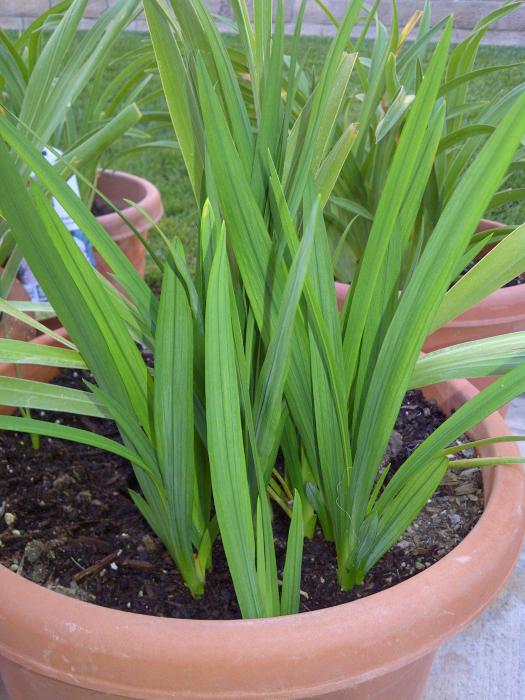

Mistakes will not allow you to get a full-fledged flowering plant. In order to solve the problem of how to grow a gladiolus with a normal developed root system, it is necessary to know the degree of its growth. It branches in the soil to a depth of forty centimeters. Full nutrition of the flower will be able to provide a layer of soil with a thickness of at least forty-five centimeters. Based on this parameter, a suitable growing container is selected. You can use large flower pots or plastic containers, the capacity of which should be at least twelve to fifteen liters.
Using hanging planters
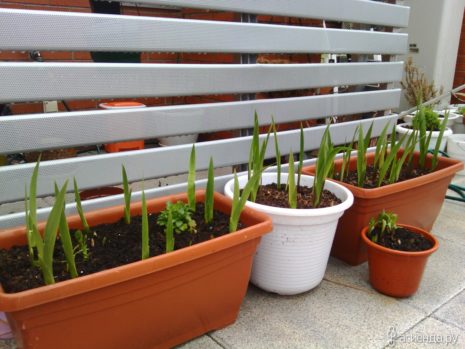

Dwarf varieties of gladioli are planted in hanging pots. The cache-pot is installed on a loggia or in another place. In windy weather, if the planter is on the street or on an unglazed balcony, it must be removed into the house. The wind can break long flowers.
Otherwise, growing in pots is no different from planting in pots. Gladioli care is carried out in the ways described above.
With proper planting and care, gladioli will bloom for a long time and profusely, decorating a balcony or plot with their inflorescences. When the plants bloom, the stem is cut off, and the bulb is dug up, dried and harvested to be stored for the winter in a cool, dark place. The next year, she can be planted again.
Bulb preparation rules
Indoor gladiolus corms need to be selected correctly. The most promising planting material for obtaining abundant flowering is bulbs, the diameter of which varies within 2-4 cm with a bottom size of 0.3-0.7 cm. The bulbs must not be shriveled. There should be no brown spots or mold marks on the surface. It is recommended to give preference to planting material with one, but well-developed and powerful sprout. It is these bulbs that bloom best and form a large baby.
Corms before carrying out pre-planting treatment must be cleaned of dry integumentary scales, under which pathogenic spores may persist. A careful examination should discard diseased bulbs, and treat the planting material suitable for planting with a solution of fungicides. A good result is given by the use of the drug "Maxim" or "Fundazol", which can be replaced with a solution of potassium permanganate, Bordeaux mixture or copper oxychloride. The fight against plant parasites is carried out with drugs "Aktara" or "Karbofos".
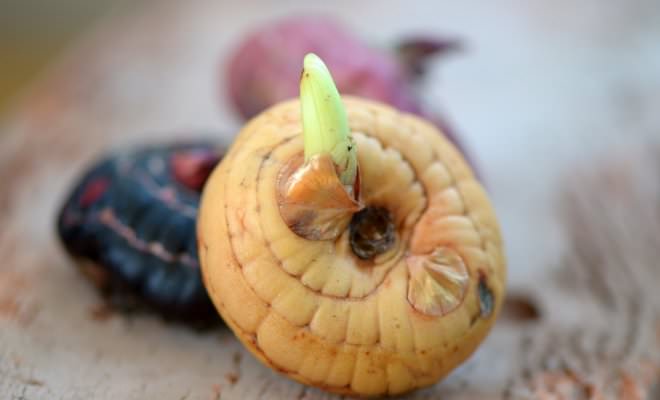

To stimulate growth processes, as well as to increase the number of peduncles and the quality of flowering, corms of an ornamental culture must be soaked in a solution of microelements or with the addition of Cytovit. Experienced flower growers independently make a mixture for soaking gladiolus bulbsmixing potassium permanganate, boric acid, copper sulfate, zinc sulfate, ammonium molybdate and magnesium sulfate in a ratio of 2: 2: 2: 0.5: 1: 2 grams per bucket of clean water. In this state, the planting material is processed within 6-12 hours.
A good result is obtained by additional processing of gladiolus bulbs with special root formation stimulants, which can be used as "Epin", "Zircon", "Kornevin" or "Kornerostom"as well as humic acids. After processing, the corms need to be laid out in one layer in boxes, which are installed in a dry, well-lit and warm room. Bulbs that have not formed a sprout and root tubercles in a couple of weeks are discarded.
Reproduction of gladioli
Several methods of reproduction are used - by seeds and small baby bulbs. The latter method is more common. How to grow a gladiolus from children?
Tuber is an excellent material for breeding a skewer. Babies are formed on the main bulb. They are small in size. In order to accelerate the flowering of this planting material, in March it is sown in containers. The sowing depth is between two and three centimeters. A baby gladiolus will grow in a container until September. Plant care is the same as for flowers grown from large corms. At the end of the season, the baby grows up to three centimeters in size. In the next season, such corms will become an excellent planting material for full-fledged flowering plants.



